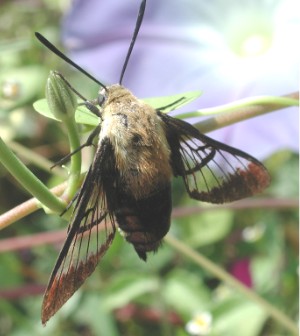
Hemaris is a genus of sphinx moths in the subfamily Macroglossinae, which is native to the Holarctic. Their main host plants are herbs and shrubs of the teasel and honeysuckle families. Moths in genus Hemaris are known collectively as clearwing moths or hummingbird moths in the US and Canada and bee hawk-moths in Britain. The related Old World hummingbird hawk-moths, genus Macroglossum, are similar in appearance and habits. Both genera have tails that are provided with an expansile truncated tuft of hairs, but only Hemaris has the disc of the wings transparent, as these scales are dropped soon after eclosion.
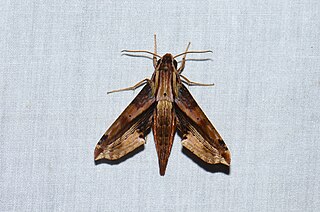
Eupanacra mydon, the common rippled hawkmoth, is a moth of the family Sphingidae.

Macroglossum affictitia, the dark-bordered hummingbird hawkmoth, is a moth of the family Sphingidae. It is known from Sri Lanka and southern India to Myanmar, Thailand and south-western Yunnan, China. It was described by Arthur Gardiner Butler in 1875.

Clanidopsis is a genus of moths in the family Sphingidae, containing only one species Clanidopsis exusta, the white-streaked hawkmoth. The genus was erected by Walter Rothschild and Karl Jordan in 1903 and the species was first described by Arthur Gardiner Butler in 1875.

Theretra pallicosta, the white-edged hunter hawkmoth, is a moth of the family Sphingidae described by Francis Walker in 1856. It is found from Sri Lanka and India, east through Nepal, Bangladesh and Myanmar to Hong Kong and Taiwan and south through Thailand, Laos and Vietnam to Peninsular Malaysia and Indonesia.

Rhagastis lunata, the lunulate mottled hawkmoth, is a moth of the family Sphingidae. It is known from Nepal, north-eastern India, Thailand, south-western China and Vietnam.

Hayesiana triopus, the nonsuch hawkmoth, is a moth of the family Sphingidae. It is known from Nepal, north-eastern India, southern China and Thailand.
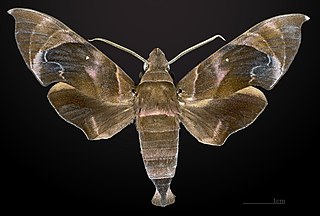
Eurypteryx bhaga, the hook-winged hawkmoth, is a moth of the family Sphingidae first described by Frederic Moore in 1866.

Eupanacra busiris, the green rippled hawkmoth, is a moth of the family Sphingidae.

Eupanacra metallica is a moth of the family Sphingidae first described by Arthur Gardiner Butler in 1875.
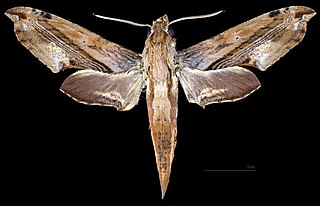
Eupanacra sinuata, the sinuous rippled hawkmoth, is a moth of the family Sphingidae. It is known from Nepal, north-eastern India, south-western China, northern Thailand and Vietnam.
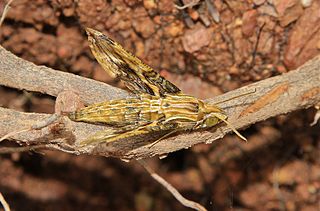
Eupanacra variolosa, the grown rippled hawkmoth, is a moth of the family Sphingidae.

Cechenena lineosa, the striped green hawkmoth, is a moth of the family Sphingidae. It is known from northern India, Nepal, Bangladesh, Myanmar, Thailand, southern China, Taiwan, Vietnam, Malaysia and Indonesia.

Hemaris beresowskii is a moth of the family Sphingidae. It is known from south-western China.
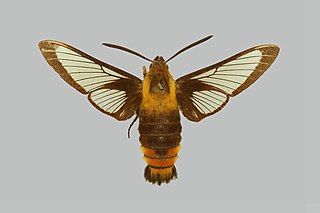
Hemaris staudingeri is a moth of the family Sphingidae. It is found from eastern and central China north to the southern part of the Russian Far East.

Hemaris aksana, the Atlas bee hawkmoth, is a moth of the family Sphingidae. The species was first described by Ferdinand Le Cerf in 1923. It is known from the Middle and High Atlas Mountains of Morocco. The habitat consists of flower-rich meadows at elevations between 1,300 and 2,500 meters.

Hemaris alaiana, the Alai bee hawkmoth, is a moth of the family Sphingidae. The species was first described by Walter Rothschild and Karl Jordan in 1903. It is known from the Alayskiy Khrebet, Tian Shan, Dzungarian Alatau, Saur and Altai mountains, from Tajikistan and eastern Kazakhstan to western Mongolia. The habitat consists of montane meadows and woodland glades rich in flowers, generally from 1,400 to 2,200 meters altitude.
Hemaris syra, the broad-bordered bee hawkmoth, is a moth of the family Sphingidae. The species was first described by Franz Daniel in 1939. It is known from southern and eastern Turkey, the western Zagros Mountains and northern Alborz Mountains of Iran, the Kopet Dag mountains of Turkmenistan, western Jordan, and northern Israel.

Hemaris saundersii, or Saunders' bee hawkmoth, is a moth of the family Sphingidae. The species was first described by Francis Walker in 1856. It is found from southern Kashmir, northern Pakistan, northern India and north-eastern Afghanistan, eastwards along the Himalayan foothills of India to Bangladesh and northern Myanmar. The habitat consists of scrub-jungle at 1,800 to 3,000 metres altitude.
Hemaris molli is a moth of the family Sphingidae. The species was first described by Ulf Eitschberger, Günter C. Müller and Vasiliy D. Kravchenko in 2005. It is known from Jordan.


















